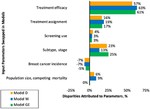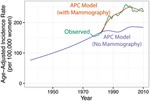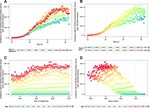CISNET
Last updated on
7 Jul 2020
Publications
Collaborative Modeling to Compare Different Breast Cancer Screening Strategies: A Decision Analysis for the US Preventive Services Task Force
IMPORTANCE The effects of breast cancer incidence changes and advances in screening and treatment on outcomes of different screening …
Amy Trentham-Dietz, Christina Chapman, Jinani Jayasekera, Katie Lowry, Brandy Heckman-Stoddard, John Hampton, Jennifer Caswell-Jin, Ronald Gangnon, Ying Lu, Hui Huang, Sarah Stein, Liyang Sun, Eugenio Gil Quessup, Yuenliang Yang, Yifan Lu, Juhee Song, Diego Munoz, Yisheng Li, Alison Kurian, Karla Kerlikowske, Ellen O’Meara, Brian Sprague, Anna Tosteson, Rocky Feuer, Don Berry, Sylvia Plevritis, Xuelin Huang, Harry de Koning, Nicolien van Ravesteyn, Sandra Lee, Oguzhan Alagoz, Clyde Schechter, Tasha Stout, Diana Miglioretti, Jeanne Mandelblatt
Population Simulation Modeling of Disparities in US Breast Cancer Mortality
Background: Self-identified African American or Black women (“Black women”) have persistently higher breast cancer mortality than women …
Breast Cancer Risk for Women with Diabetes and The Impact of Metformin – A Meta-analysis
Background: Diabetes mellitus has been associated with increased breast cancer (BC) risk; however, the magnitude of this effect is …
Common Model Inputs Used in CISNET Collaborative Breast Cancer Modeling
BACKGROUND:
Since their inception in 2000, the Cancer Intervention and Surveillance Network (CISNET) breast cancer models have …
Contribution of Breast Cancer to Overall Mortality for US Women
OBJECTIVE:
Breast cancer simulation models must take changing mortality rates into account to evaluate the potential impact of cancer …
The University of Wisconsin Breast Cancer Epidemiology Simulation Model: An Update
The University of Wisconsin Breast Cancer Epidemiology Simulation Model (UWBCS), also referred to as Model W, is a discrete-event …
Collaborative Modeling of the Benefits and Harms Associated With Different U.S. Breast Cancer Screening Strategies
BACKGROUND:
Controversy persists about optimal mammography screening strategies. OBJECTIVE:
To evaluate screening outcomes, taking into …
Jeanne Mandelblatt, Tasha Stout, Clyde Schechter, Jeroen van den Broek, Diana Miglioretti, Martin Krapcho, Amy Trentham-Dietz, Diego Munoz, Sandra Lee, Don Berry, Nicolien van Ravesteyn, Oguzhan Alagoz, Karla Kerlikowske, Anna Tosteson, Aimee Near, Amanda Hoeffken, Yaojen Chang, Eveline Heijnsdijk, Gary Chisholm, Xuelin Huang, Hui Huang, Mehmet Ergun, Ronald Gangnon, Brian Sprague, Sylvia Plevritis, Rocky Feuer, Harry de Koning, Kathy Cronin
The contribution of mammography screening to breast cancer incidence trends in the United States: an updated age-period-cohort model
BACKGROUND:
The impact of screening mammography on breast cancer incidence is difficult to disentangle from cohort- and age-related …
Variation in tumor natural history contributes to racial disparities in breast cancer stage at diagnosis
Black women tend to be diagnosed with breast cancer at a more advanced stage than whites and subsequently experience elevated breast …




